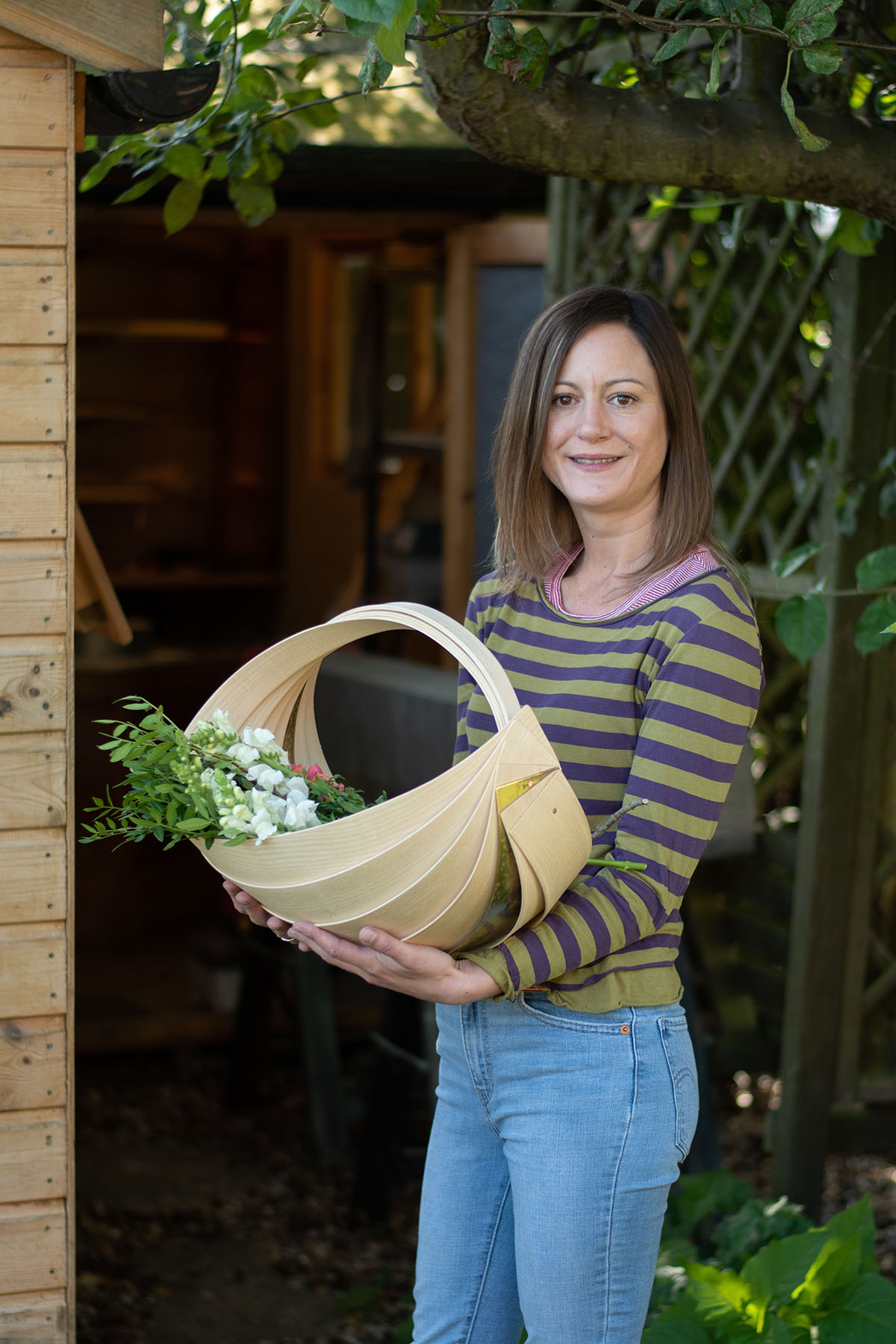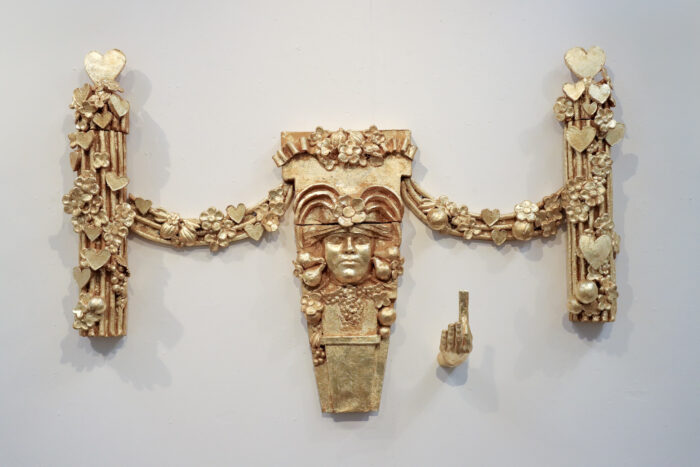Maker in Focus: Jane Crisp

In this month’s Maker in Focus interview, we spoke to trug maker Jane Crisp about her love for wood from a young age, her inspiration from nature, how she uses boat builder’s techniques and the importance of pushing boundaries through experimentation as a craftsperson.
Jane Crisp’s is part of the maker community at The Room Service, her work was featured at the talk and demonstration, “Canapés, Ceramics & Conversation: with Roux Scholar Dan Cox and The Room Service” during LCW 2018.

LCW: What is your background?
JC: I’ve always loved making and I have been drawn to wood from a young age. I travelled quite a lot when I was younger and then after settling down in Norfolk, I began to educate myself with the skills I needed to realise my designs. I went to college and then Bucks New Uni and studied furniture design and craft. I graduated and set up my business making trugs from borrowed spaces. I now live in Hale Fen, Cambridgeshire working from my home studio and lovely purpose-built workshop.
LCW: How have you developed your career? Was there a pivotal moment that drew you to your craft?
JC: My pivotal moment or DNA of my practice happened when I lived on a boat. I started making things to help me live and I was inspired by the nature that surrounded me. I became interested in tradition and evolutionary crafts. My trugs are a direct example of this moment, they are built using boat-builder’s techniques, steam-bending and clinker construction, the components shapes are inspired by the reeds that line the fields and rivers and if you catch them in the wind they will rock like boats.
I got my work out there entering competitions and exhibiting at shows. I was a Crafts Council Hothouse participant. Being under the Crafts Council umbrella really helped and I got coverage in lots of magazines and won awards at shows. I have built relationships with some great companies most recently started working with a wonderful new company called The Room Service www.theroomservice.co who sell beautiful pieces of craft, as seen in design-led spaces such as hotels and restaurants. They really understand what I do and portray the special details in my designs perfectly. Being involved with them and being a part of their incredible curation has really built my confidence and propelled me in the craft world. It seems to have snowballed and lots of new and exciting opportunities have appeared for my business.
LCW: What does your typical day look like?
JC: I start with a coffee and check my weekly planner and work out what making I have to do during the day. I sit and check my emails and notifications, slurping my coffee whilst adding jobs to my lists. I run around the house tidying up and then open the workshop, always by nine or before, I get the heater on and clean, hoover and set up for making. I’m already in the zone by this point, I feel more relaxed now I’m outside and there’s pace, enthusiasm and rhythm to my work. I have to balance this though with focus like any practise or discipline. I try to come in from my workshop by five, light a fire cook, eat and work on my designs and my laptop.

LCW: What role does craft and making have in society?
JC: Craft says something, reminds you of something, craft creates dialect, an emotional language of its own. It’s engineering solutions to aid living and something that’s treasured and passed down through thousands of years of evolution. It brings biophilic design to interiors, connects us to nature and brings culture, personality and joy to our lives. It challenges our thinking and pushes new limits. Most of all though it brings people together as they share knowledge, craft stories and enthusiasm.
LCW: How long does it take for someone to really build confidence in their craft?
JC: I am building confidence in my craft and it’s hugely satisfying. I don’t know if it ever fully happens but I’m sure this is part of the attraction. It’s like figuring things out all the time and pushing things further so it grows and never ends. I began by pushing traditional craft practises to expose the properties of materials and create the “how-did-you-do-that” factor. At university, I made a steam-bent desk called the paper trail of life. There were no uprights and the piece relied on triangulating the joints for structural strength. I asked my tutor if he thought it would work and he said I don’t know. It worked and I sold the piece but this way of working has a lot of unknowns. It creates identity within my work but also loads of experimentation and product development work.
LCW: What are the positives/negatives about being a craftsperson?
JC: Every day when I get outside and into my workshop, I feel grateful that I’m able to make for a living. I go a little crazy if don’t make and when I do I’m at my best. I really hate spiders and I can be isolated at my busiest times.

LCW: What’s one thing you would most like to own?
JC: A wood with a river connected to the waterway system and a mooring with a narrow boat. I would use the timber to make my work, coppice, manage the woodland, forage and build a big tree house cabin. I would, of course, need a pole lathe, workshop and wind turbine with water on sight. It would be something to nurture, preserve and pass down.
LCW: Is there another career path that you could have chosen?
JC: I have been a volunteer at Oxburgh Hall in Norfolk for nearly a year and I love it. I’m a Conservation Assistant working close up with the collection. The more I’ve become a part of the story of Oxburgh the more I’ve fallen in love with the house. I’ve gained knowledge through amazing National Trust courses and inspiration creatively. I’ve got three new sculptures and a product range based on the house that I will be releasing next year to help raise money for the Raise the Roof restoration project happening in 2019. I love getting close up with the craftsmanship and I actually love learning about history and preserving it for the future.
LCW: Do you have someone that you idolize? Craftsperson or otherwise.
JC: Sebastian Cox is someone I really look up to. He was a mentor for me during the Hothouse program. I saw some of his sketches and technical drawings at a presentation and they were fascinating. I love the way he pushes new processes and creates a strong identity. He is also a woodsman, an extremely talented maker and a great businessman too.
LCW: What is craft to you? What does it represent?
JC: Craft for me is my place to go, a place where I can truly be myself. It’s who I am and I am my craft. It’s my respect for materials and an expression of myself. I go to craft to celebrate and create but also to be in the now and forget everything else. Craft represents thoughts of others, tales and mythologies passed down. It represents history and amplifies tales of eras, technologies, scientific developments and cultural beliefs.


